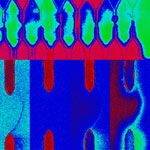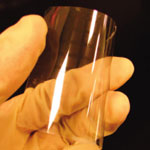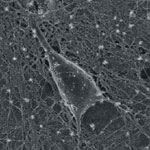Showing Spotlights 169 - 176 of 315 in category All (newest first):
 Just a few days ago we covered the exciting and quickly developing world of nanotechnology machinery, specifically nanomotors. In this previous Nanowerk Spotlight we focused on one approach to nanomotors, which is copying nature's catalytic biomotors. Today we will look at an example of mechanical approach that works with carbon nanotubes (CNTs). Some experimental work concerning CNT motor system has already been reported, but new work coming out of Japan could very well be the smallest motor so far. Researchers in Japan investigated the linear and rotary motions of a CNT capsule at room temperature when it is sealed by other CNTs in a hollow space of a host CNT. It is the first observation of linear motion of CNT capsules. Such a system can be obtained by simply heating C60 peapods, and its size is comparable or much smaller than well-known protein-based molecular motors in the bioengineering field.
Just a few days ago we covered the exciting and quickly developing world of nanotechnology machinery, specifically nanomotors. In this previous Nanowerk Spotlight we focused on one approach to nanomotors, which is copying nature's catalytic biomotors. Today we will look at an example of mechanical approach that works with carbon nanotubes (CNTs). Some experimental work concerning CNT motor system has already been reported, but new work coming out of Japan could very well be the smallest motor so far. Researchers in Japan investigated the linear and rotary motions of a CNT capsule at room temperature when it is sealed by other CNTs in a hollow space of a host CNT. It is the first observation of linear motion of CNT capsules. Such a system can be obtained by simply heating C60 peapods, and its size is comparable or much smaller than well-known protein-based molecular motors in the bioengineering field.
Feb 17th, 2009
 One of the many application areas that carbon nanotubes (CNTs) are experimented with is as a drug carrier in nanomedicine. Typically, nanoparticles have been used for drug delivery and it is only recently that carbon nanotubes have gained attention as potential drug delivery vehicles. Current research has shown the ability of CNTs to carry a variety of molecules such as drugs, DNA, proteins, peptides, targeting ligands etc. into cells - which makes them suitable candidates for targeted delivery applications. Polyethylene glycol (PEG) with molecular weight between 1 and 40 kDa is usually used to coat drug or imaging nanocarriers with the purpose of reducing non-specific interactions with cells and thus increasing the nanocarriers circulation time in vivo. However, when PEG in the form of PL-PEG (adsorbing phospholipid-PEG) has been used to functionalize single-walled CNTs, the finding were not consistent, sometimes even contradictory.
One of the many application areas that carbon nanotubes (CNTs) are experimented with is as a drug carrier in nanomedicine. Typically, nanoparticles have been used for drug delivery and it is only recently that carbon nanotubes have gained attention as potential drug delivery vehicles. Current research has shown the ability of CNTs to carry a variety of molecules such as drugs, DNA, proteins, peptides, targeting ligands etc. into cells - which makes them suitable candidates for targeted delivery applications. Polyethylene glycol (PEG) with molecular weight between 1 and 40 kDa is usually used to coat drug or imaging nanocarriers with the purpose of reducing non-specific interactions with cells and thus increasing the nanocarriers circulation time in vivo. However, when PEG in the form of PL-PEG (adsorbing phospholipid-PEG) has been used to functionalize single-walled CNTs, the finding were not consistent, sometimes even contradictory.
Feb 16th, 2009
 Platinum nanoparticles are widely used as the cathode material in hydrogen/oxygen fuel cells due to their efficiency in catalyzing the oxygen reduction reaction (ORR), the process that breaks the bonds of the oxygen molecules. Although platinum is still considered the state-of-the-art ORR catalyst, it does not exhibit good stability. Typically, catalyst performance degradation begins as soon as the catalyst is introduced into a fuel cell and continues until it is no longer active. Platinum can lose its effectiveness either by clumping together or by becoming 'poisoned' by carbon monoxide, requiring high hydrogen purity or higher catalyst densities for the fuel cell to stay effective. This, together with the high cost of platinum is seen as one of the major showstoppers to producing mass market fuel cells for commercial applications. Researchers now found that vertically-aligned nitrogen-containing carbon nanotubes could be used as effective ORR electrocatalysts.
Platinum nanoparticles are widely used as the cathode material in hydrogen/oxygen fuel cells due to their efficiency in catalyzing the oxygen reduction reaction (ORR), the process that breaks the bonds of the oxygen molecules. Although platinum is still considered the state-of-the-art ORR catalyst, it does not exhibit good stability. Typically, catalyst performance degradation begins as soon as the catalyst is introduced into a fuel cell and continues until it is no longer active. Platinum can lose its effectiveness either by clumping together or by becoming 'poisoned' by carbon monoxide, requiring high hydrogen purity or higher catalyst densities for the fuel cell to stay effective. This, together with the high cost of platinum is seen as one of the major showstoppers to producing mass market fuel cells for commercial applications. Researchers now found that vertically-aligned nitrogen-containing carbon nanotubes could be used as effective ORR electrocatalysts.
Feb 5th, 2009
 Typically, nanoparticles have been used for drug delivery and it has been only recently that carbon nanotubes (CNTs) have gained attention as potential drug delivery vehicles. Carbon nanotubes offer a number of advantages which suggest that they may provide an improved result over nanoparticles. They have a larger inner volume which allows more drug molecules to be encapsulated, and this volume is more easily accessible because the end caps can be easily removed, and they have distinct inner and outer surfaces for functionalization. Current research has shown the ability of CNTs to carry a variety of molecules such as drugs, DNA, proteins, peptides, targeting ligands etc. into cells - which makes them suitable candidates for targeted delivery applications. Despite these advantages, a suitable delivery system has not been developed yet for the targeted delivery of CNTs to specific sites.
A research team from various Canadian and U.S. universities has now demonstrated, for the first time, the design and development of a novel microcapsule carbon nanotube targeted delivery device.
Typically, nanoparticles have been used for drug delivery and it has been only recently that carbon nanotubes (CNTs) have gained attention as potential drug delivery vehicles. Carbon nanotubes offer a number of advantages which suggest that they may provide an improved result over nanoparticles. They have a larger inner volume which allows more drug molecules to be encapsulated, and this volume is more easily accessible because the end caps can be easily removed, and they have distinct inner and outer surfaces for functionalization. Current research has shown the ability of CNTs to carry a variety of molecules such as drugs, DNA, proteins, peptides, targeting ligands etc. into cells - which makes them suitable candidates for targeted delivery applications. Despite these advantages, a suitable delivery system has not been developed yet for the targeted delivery of CNTs to specific sites.
A research team from various Canadian and U.S. universities has now demonstrated, for the first time, the design and development of a novel microcapsule carbon nanotube targeted delivery device.
Jan 19th, 2009
 Olfaction, our sense of smell, depends on the capability of specialized sensory cells in the nose to detect airborne odorant molecules. These olfactory cells contain specific protein molecules that acts as 'olfactory receptors' - they bind only to specific odorant molecules present in the air inhaled through the nose. When such a binding event occurs, the olfactory receptors change their shape and this deformation triggers chemical and electrical signals which are eventually transmitted to the brain through neurons. So, in a nutshell, this is how we smell. Human and especially some animal noses (think bomb-sniffing dogs) are very sophisticated and extremely sensitive gas sensors that can distinguish between very similar gas molecules. Researchers have been trying for a while to replicate the human olfactory sense - a concept called electronic nose (e-nose). While most nanotechnology-based efforts have focused on nanowires, new research conducted in Korea has demonstrated the detection of specific odorant molecules with a single-carbon-atomic resolution using a human olfactory receptor-functionalized carbon nanotube based sensor.
Olfaction, our sense of smell, depends on the capability of specialized sensory cells in the nose to detect airborne odorant molecules. These olfactory cells contain specific protein molecules that acts as 'olfactory receptors' - they bind only to specific odorant molecules present in the air inhaled through the nose. When such a binding event occurs, the olfactory receptors change their shape and this deformation triggers chemical and electrical signals which are eventually transmitted to the brain through neurons. So, in a nutshell, this is how we smell. Human and especially some animal noses (think bomb-sniffing dogs) are very sophisticated and extremely sensitive gas sensors that can distinguish between very similar gas molecules. Researchers have been trying for a while to replicate the human olfactory sense - a concept called electronic nose (e-nose). While most nanotechnology-based efforts have focused on nanowires, new research conducted in Korea has demonstrated the detection of specific odorant molecules with a single-carbon-atomic resolution using a human olfactory receptor-functionalized carbon nanotube based sensor.
Jan 8th, 2009
 One of the issues in using carbon nanotubes for applications is the challenge of separating metallic from semiconducting single-walled carbon nanotubes (SWCNT) after production. Developing a rapid and parallel technique for the electronic characterization of high-density arrays of SWCNT devices is essential for future large-scale production processes of nanoelectronics components. Currently used methods for electronic characterization of SWCNT devices and arrays are time consuming to set up, slow to execute, and not suitable for large-scale deployment. These methods include direct electron transport measurements and scanning probe microscopy, which can map the surface potential along a nanotube; again, a very slow technique with limited ability to be integrated into the process flow for microelectronic fabrication and characterization. More recent demonstrations of sorting nanotubes with DNA have been more promising but are very early stage. Researchers in Germany have now presented Voltage-Contrast Scanning Electron Microscopy (VC-SEM) as a new technique for the characterization of molecular electronic devices and device arrays.
One of the issues in using carbon nanotubes for applications is the challenge of separating metallic from semiconducting single-walled carbon nanotubes (SWCNT) after production. Developing a rapid and parallel technique for the electronic characterization of high-density arrays of SWCNT devices is essential for future large-scale production processes of nanoelectronics components. Currently used methods for electronic characterization of SWCNT devices and arrays are time consuming to set up, slow to execute, and not suitable for large-scale deployment. These methods include direct electron transport measurements and scanning probe microscopy, which can map the surface potential along a nanotube; again, a very slow technique with limited ability to be integrated into the process flow for microelectronic fabrication and characterization. More recent demonstrations of sorting nanotubes with DNA have been more promising but are very early stage. Researchers in Germany have now presented Voltage-Contrast Scanning Electron Microscopy (VC-SEM) as a new technique for the characterization of molecular electronic devices and device arrays.
Jan 7th, 2009
 The emerging field of transparent and flexible electronics not only holds the promise of a new class of device components that would be more environmentally benign than current electronics; being able to print transparent circuits on low-cost and flexible plastic substrates also opens up the possibility of a wide range of new applications, ranging from windshield displays and flexible solar cells to clear toys and artificial skins and even sensor implants. Three broad application areas for this technology are taking shape: transparent displays; flexible displays; and transparent/flexible electronics. Traditional materials used for transparent electronics include indium tin oxide films and indium oxide nanowires. In their search for materials that can offer even higher mobility and therefore even better performance, researchers have turned to single-walled carbon nanotubes .New work at the University of Southern California has now demonstrated the great potential of massively aligned single-walled carbon nanotubes for high-performance transparent electronics.
The emerging field of transparent and flexible electronics not only holds the promise of a new class of device components that would be more environmentally benign than current electronics; being able to print transparent circuits on low-cost and flexible plastic substrates also opens up the possibility of a wide range of new applications, ranging from windshield displays and flexible solar cells to clear toys and artificial skins and even sensor implants. Three broad application areas for this technology are taking shape: transparent displays; flexible displays; and transparent/flexible electronics. Traditional materials used for transparent electronics include indium tin oxide films and indium oxide nanowires. In their search for materials that can offer even higher mobility and therefore even better performance, researchers have turned to single-walled carbon nanotubes .New work at the University of Southern California has now demonstrated the great potential of massively aligned single-walled carbon nanotubes for high-performance transparent electronics.
Jan 6th, 2009
 Neural engineering is an emerging discipline that uses engineering techniques to investigate the function and manipulate the behavior of the central or peripheral nervous systems. Neural engineering is highly interdisciplinary and relies on expertise from computational neuroscience, experimental neuroscience, clinical neurology, electrical engineering and signal processing of living neural tissue, and encompasses elements from robotics, computer engineering, neural tissue engineering, materials science, and nanotechnology. In order for neural prostheses to augment or restore damaged or lost functions of the nervous system they need to be able to perform two main functions: stimulate the nervous system and record its activity. To do that, neural engineers have to gain a full understanding of the fundamental mechanisms and subtleties of cell-to-cell signaling via synaptic transmission, and then develop the technologies to replicate these mechanisms with artificial devices and interface them to the neural system at the cellular level. A group of European researchers has now shown that carbon nanotubes may become the ideal material for repairing damaged brain tissue.
Neural engineering is an emerging discipline that uses engineering techniques to investigate the function and manipulate the behavior of the central or peripheral nervous systems. Neural engineering is highly interdisciplinary and relies on expertise from computational neuroscience, experimental neuroscience, clinical neurology, electrical engineering and signal processing of living neural tissue, and encompasses elements from robotics, computer engineering, neural tissue engineering, materials science, and nanotechnology. In order for neural prostheses to augment or restore damaged or lost functions of the nervous system they need to be able to perform two main functions: stimulate the nervous system and record its activity. To do that, neural engineers have to gain a full understanding of the fundamental mechanisms and subtleties of cell-to-cell signaling via synaptic transmission, and then develop the technologies to replicate these mechanisms with artificial devices and interface them to the neural system at the cellular level. A group of European researchers has now shown that carbon nanotubes may become the ideal material for repairing damaged brain tissue.
Dec 29th, 2008
 Just a few days ago we covered the exciting and quickly developing world of nanotechnology machinery, specifically nanomotors. In this previous Nanowerk Spotlight we focused on one approach to nanomotors, which is copying nature's catalytic biomotors. Today we will look at an example of mechanical approach that works with carbon nanotubes (CNTs). Some experimental work concerning CNT motor system has already been reported, but new work coming out of Japan could very well be the smallest motor so far. Researchers in Japan investigated the linear and rotary motions of a CNT capsule at room temperature when it is sealed by other CNTs in a hollow space of a host CNT. It is the first observation of linear motion of CNT capsules. Such a system can be obtained by simply heating C60 peapods, and its size is comparable or much smaller than well-known protein-based molecular motors in the bioengineering field.
Just a few days ago we covered the exciting and quickly developing world of nanotechnology machinery, specifically nanomotors. In this previous Nanowerk Spotlight we focused on one approach to nanomotors, which is copying nature's catalytic biomotors. Today we will look at an example of mechanical approach that works with carbon nanotubes (CNTs). Some experimental work concerning CNT motor system has already been reported, but new work coming out of Japan could very well be the smallest motor so far. Researchers in Japan investigated the linear and rotary motions of a CNT capsule at room temperature when it is sealed by other CNTs in a hollow space of a host CNT. It is the first observation of linear motion of CNT capsules. Such a system can be obtained by simply heating C60 peapods, and its size is comparable or much smaller than well-known protein-based molecular motors in the bioengineering field.
 Subscribe to our Nanotechnology Spotlight feed
Subscribe to our Nanotechnology Spotlight feed





